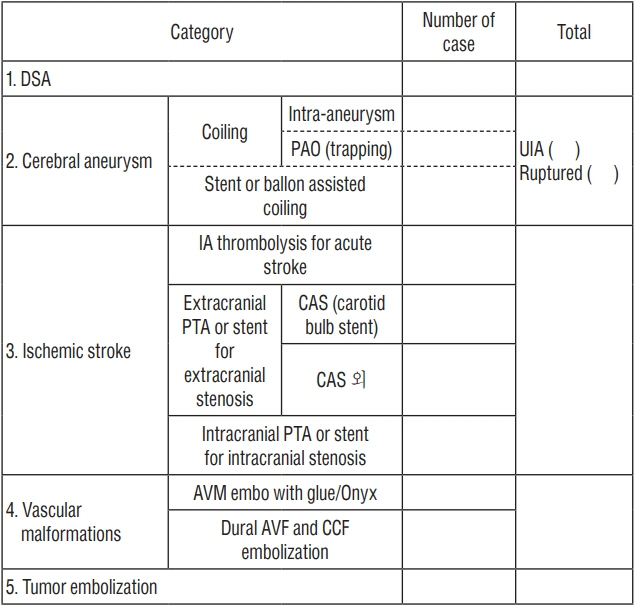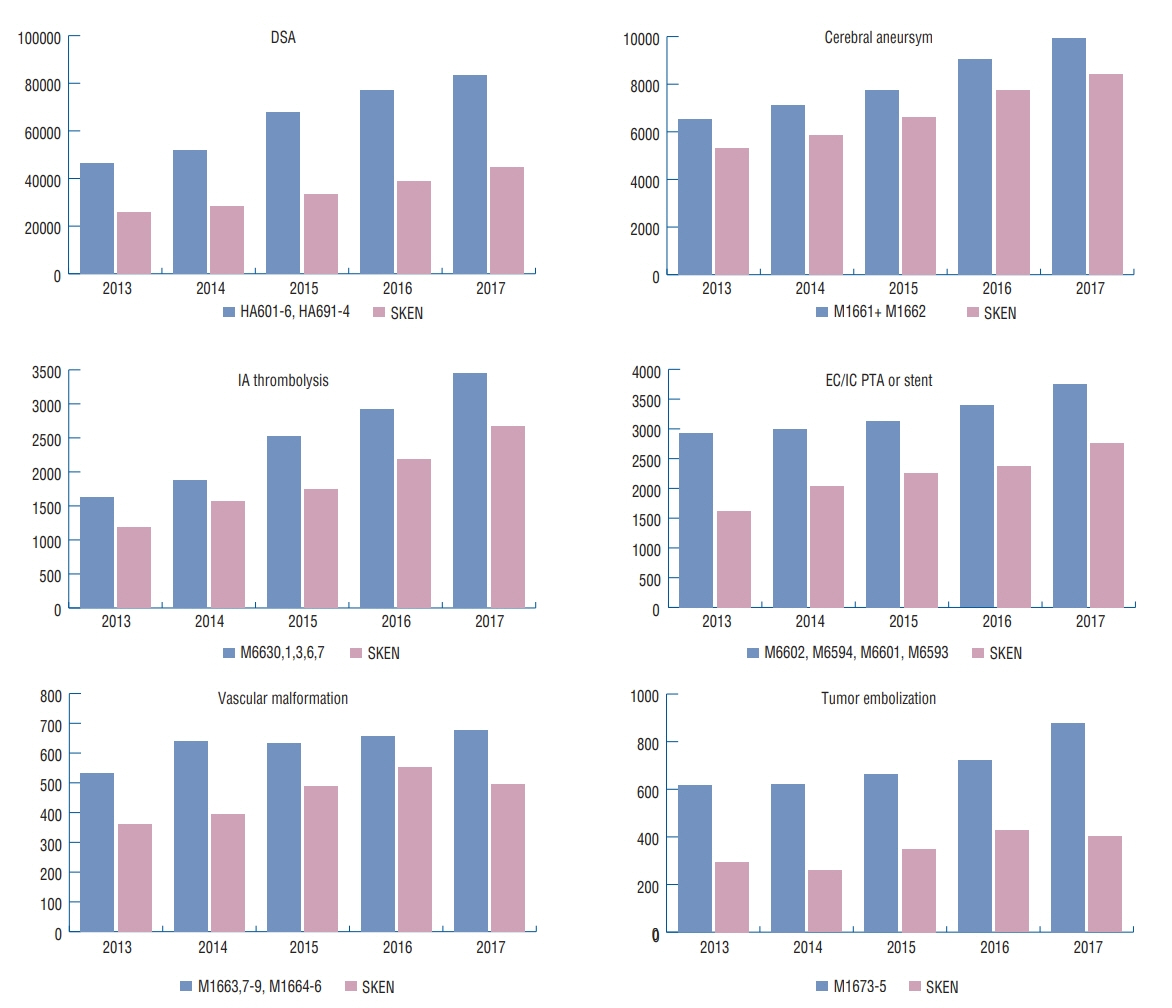J Korean Neurosurg Soc.
2019 Sep;62(5):502-518. 10.3340/jkns.2018.0216.
Endovascular Treatments Performed Collaboratively by the Society of Korean Endovascular Neurosurgeons Members: A Nationwide Multicenter Survey
- Affiliations
-
- 1Department of Neurosurgery, CHA Bundang Medical Center, CHA University School of Medicine, Seongnam, Korea.
- 2Department of Neurosurgery, Seoul National University Bundang Hospital, Seongnam, Korea.
- 3Department of Neurosurgery, Seoul St. Mary’s Hospital, College of Medicine, The Catholic University of Korea, Seoul, Korea.
- 4Department of Neurosurgery, St. Vincent’s Hospital, College of Medicine, The Catholic University of Korea, Suwon, Korea.
- 5Department of Neurosurgery, Kyung Hee University Hospital at Gangdong, Seoul, Korea.
- 6Department of Neurosurgery, Soonchunhyang University Bucheon Hospital, Bucheon, Korea. bumtkim@gmail.com
- KMID: 2457940
- DOI: http://doi.org/10.3340/jkns.2018.0216
Abstract
OBJECTIVE
Since less invasive endovascular treatment was introduced to South Korea in 1994, a considerable proportion of endovascular treatments have been performed by neuroradiology doctors, and endovascular treatments by vascular neurosurgeons have recently increased. However, few specific statistics are known regarding how many endovascular treatments are performed by neurosurgeons. Thus, authors compared endovascular treatments collaboratively performed by vascular neurosurgeons with all cases throughout South Korea from 2013 to 2017 to elucidate the role of neurosurgeons in the field of endovascular treatment in South Korea.
METHODS
The Society of Korean Endovascular Neurosurgeons (SKEN) has issued annual reports every year since 2014. These reports cover statistics on endovascular treatments collaboratively or individually performed by SKEN members from 2013 to 2017. The data was requested and collected from vascular neurosurgeons in various hospitals. The study involved 77 hospitals in its first year, and 100 in its last. National statistics on endovascular treatment from all over South Korea were obtained from the Healthcare Bigdata Hub website of the Health Insurance Review & Assessment Service based on the Electronic Data Interchange (EDI) codes (in the case of intra-arterial (IA) thrombolysis, however, statistics were based on a combination of the EDI and I63 codes, a cerebral infarction disease code) from 2013 to 2017. These two data sets were directly compared and the ratios were obtained.
RESULTS
Regionally, during the entire study period, endovascular treatments by SKEN members were most common in Gyeonggi-do, followed by Seoul and Busan. Among the endovascular treatments, conventional cerebral angiography was the most common, followed by cerebral aneurysmal coiling, endovascular treatments for ischemic stroke, and finally endovascular treatments for vascular malformation and tumor embolization. The number of endovascular treatments performed by SKEN members increased every year.
CONCLUSION
The SKEN members have been responsible for the major role of endovascular treatments in South Korea for the recent 5 years. This was achieved through the perseverance of senior members who started out in the midst of hardship, the establishment of standards for the training/certification of endovascular neurosurgery, and the enthusiasm of current SKEN members who followed. To provide better treatment to patients, we will have to make further progress in SKEN.
MeSH Terms
Figure
Cited by 2 articles
-
Milk Fat Globule-Epidermal Growth Factor VIII Ameliorates Brain Injury in the Subacute Phase of Cerebral Ischemia in an Animal Model
Jong-Il Choi, Ho-Young Kang, Choongseong Han, Dong-Hun Woo, Jong-Hoon Kim, Dong-Hyuk Park
J Korean Neurosurg Soc. 2020;63(2):163-170. doi: 10.3340/jkns.2019.0188.The Evolution of Flow-Diverting Stents for Cerebral Aneurysms; Historical Review, Modern Application, Complications, and Future Direction
Dong-Seong Shin, Christopher P. Carroll, Mohammed Elghareeb, Brian L. Hoh, Bum-Tae Kim
J Korean Neurosurg Soc. 2020;63(2):137-152. doi: 10.3340/jkns.2020.0034.
Reference
-
References
1. Brilstra EH, Rinkel GJ, van der Graaf Y, van Rooij WJ, Algra A. Treatment of intracranial aneurysms by embolization with coils: a systematic review. Stroke. 30:470–476. 1999.
Article2. Byrne JV, Molyneux AJ, Brennan RP, Renowden SA. Embolisation of recently ruptured intracranial aneurysms. J Neurol Neurosurg Psychiatry. 59:616–620. 1995.
Article3. Connolly ES Jr, Rabinstein AA, Carhuapoma JR, Derdeyn CP, Dion J, Higashida RT, et al. Guidelines for the management of aneurysmal subarachnoid hemorrhage: a guideline for healthcare professionals from the American Heart Association/American Stroke Association. Stroke. 43:1711–1737. 2012.
Article4. Guglielmi G, Viñuela F, Dion J, Duckwiler G. Electrothrombosis of saccular aneurysms via endovascular approach. Part 2: preliminary clinical experience. J Neurosurg. 75:8–14. 1991.5. Linn FH, Rinkel GJ, Algra A, van Gijn J. Incidence of subarachnoid hemorrhage: role of region, year, and rate of computed tomography: a metaanalysis. Stroke. 27:625–629. 1996.6. McKissock W, Richardson A, Walsh L. "Posterior-communicating" aneurysms: a controlled trial of the conservative and surgical treatment of ruptured aneurysms of the internal carotid artery at or near the point of origin of the posterior communicating artery. The Lancet. 275:1203–1206. 1960.7. McKissock W, Richardson A, Walsh L. Middle-cerebral aneurysms further results in the controlled trial of conservative and surgical treatment of ruptured intracranial aneurysms. The Lancet. 280:417–421. 1962.
Article8. McKissock W, Richardson A, Walsh L. Anterior communicating aneurysms: a trial of conservative and surgical treatment. Lancet. 1:874–876. 1965.
Article9. Meyer FB, Morita A, Puumala MR, Nichols DA. Medical and surgical management of intracranial aneurysms. Mayo Clin Proc. 70:153–172. 1995.
Article10. Mohr JP, Parides MK, Stapf C, Moquete E, Moy CS, Overbey JR, et al. Medical management with or without interventional therapy for unruptured brain arteriovenous malformations (ARUBA): a multicentre, nonblinded, randomised trial. Lancet. 383:614–621. 2014.
Article11. Molyneux A, Kerr R, Stratton I, Sandercock P, Clarke M, Shrimpton J, et al. International subarachnoid aneurysm trial (ISAT) of neurosurgical clipping versus endovascular coiling in 2143 patients with ruptured intracranial aneurysms: a randomised trial. Lancet. 360:1267–1274. 2002.
Article12. Molyneux AJ, Birks J, Clarke A, Sneade M, Kerr RS. The durability of endovascular coiling versus neurosurgical clipping of ruptured cerebral aneurysms: 18 year follow-up of the UK cohort of the international subarachnoid aneurysm trial (ISAT). Lancet. 385:691–697. 2015.
Article13. Molyneux AJ, Kerr RS, Birks J, Ramzi N, Yarnold J, Sneade M, et al. Risk of recurrent subarachnoid haemorrhage, death, or dependence and standardised mortality ratios after clipping or coiling of an intracranial aneurysm in the international subarachnoid aneurysm trial (ISAT): long-term follow-up. Lancet Neurol. 8:427–433. 2009.
Article14. Molyneux AJ, Kerr RS, Yu LM, Clarke M, Sneade M, Yarnold JA, et al. International subarachnoid aneurysm trial (ISAT) of neurosurgical clipping versus endovascular coiling in 2143 patients with ruptured intracranial aneurysms: a randomised comparison of effects on survival, dependency, seizures, rebleeding, subgroups, and aneurysm occlusion. Lancet. 366:809–817. 2005.
Article15. Nichols DA. Endovascular treatment of the acutely ruptured intracranial aneurysm. J Neurosurg. 79:1–2. 1993.
Article16. Park HR, Park SQ, Kim JH, Hwang JC, Lee GS, Chang JC. Geographic analysis of neurosurgery workforce in Korea. J Korean Neurosurg Soc. 61:105–113. 2018.
Article17. Shin DS, Park SQ, Kang HS, Yoon SM, Cho JH, Lim DJ, et al. Standards for endovascular neurosurgical training and certification of the society of korean endovascular neurosurgeons 2013. J Korean Neurosurg Soc. 55:117–124. 2014.
Article18. Thompson BG, Brown RD Jr, Amin-Hanjani S, Broderick JP, Cockroft KM, Connolly ES Jr, et al. Guidelines for the management of patients with unruptured intracranial aneurysms: a guideline for healthcare professionals from the American Heart Association/American Stroke Association. Stroke. 46:2368–2400. 2015.
Article19. Veith FJ. Presidential address: Charles Darwin and vascular surgery. J Vasc Surg. 25:8–18. 1997.
Article
- Full Text Links
- Actions
-
Cited
- CITED
-
- Close
- Share
- Similar articles
-
- Future Role of Neurosurgeons: Toward Convergence Neurosurgeon Beyond Hybrid Neurosurgeon
- Current Status and Future Prospect of Endovascular Neurosurgery
- Standards for Endovascular Neurosurgical Training and Certification of the Society of Korean Endovascular Neurosurgeons 2013
- The Role of Neurosurgeons in the Era of Intra-Aneurysmal Treatment
- Complications after Endovascular Treatment





